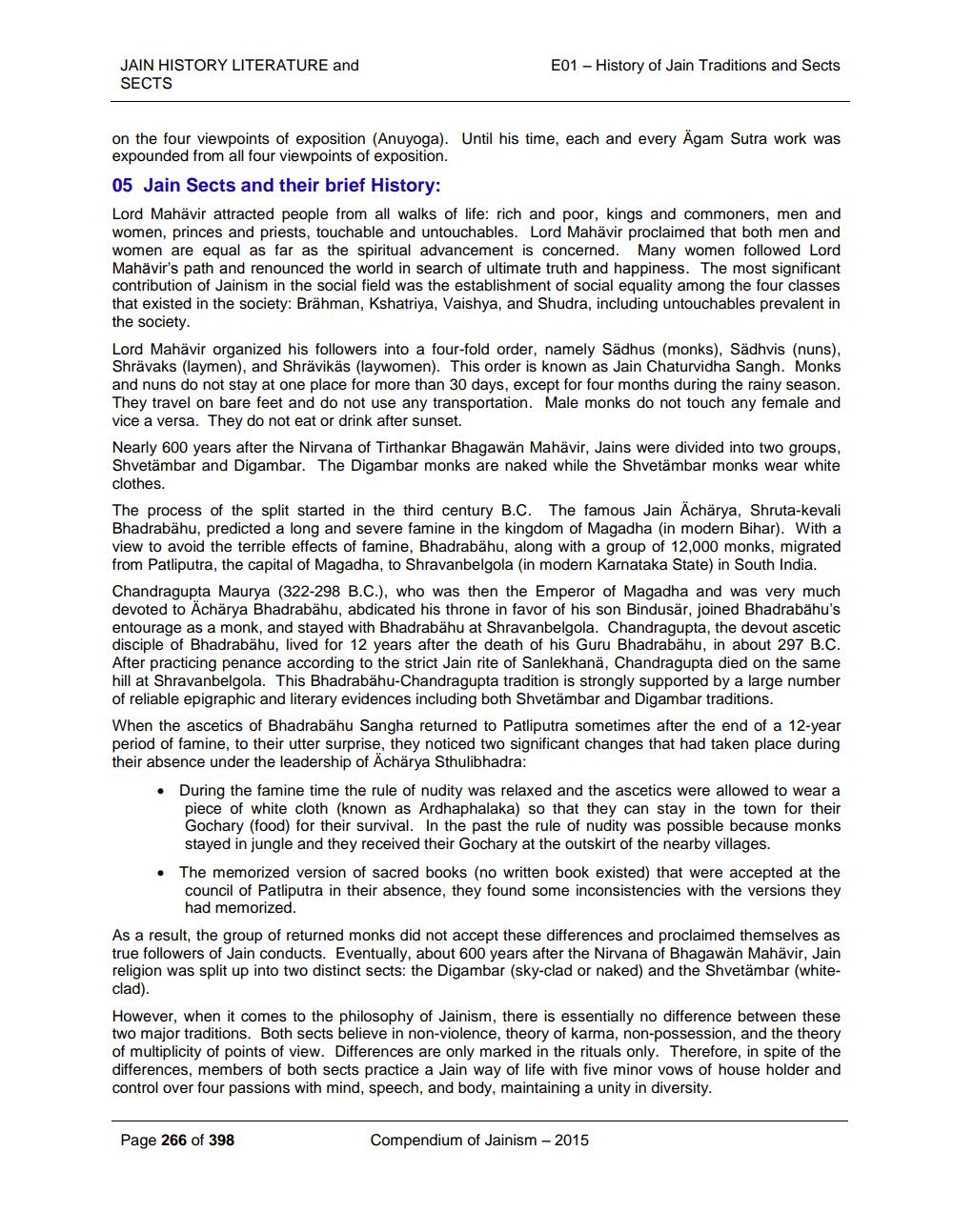________________
JAIN HISTORY LITERATURE and SECTS
E01 - History of Jain Traditions and Sects
on the four viewpoints of exposition (Anuyoga). Until his time, each and every Agam Sutra work was expounded from all four viewpoints of exposition. 05 Jain Sects and their brief History: Lord Mahävir attracted people from all walks of life: rich and poor, kings and commoners, men and women, princes and priests, touchable and untouchables. Lord Mahävir proclaimed that both men and women are equal as far as the spiritual advancement is concerned. Many women followed Lord Mahävir's path and renounced the world in search of ultimate truth and happiness. The most significant contribution of Jainism in the social field was the establishment of social equality among the four classes that existed in the society: Brähman, Kshatriya, Vaishya, and Shudra, including untouchables prevalent in the society. Lord Mahävir organized his followers into a four-fold order, namely Sädhus (monks), Sadhvis (nuns), Shrävaks (laymen), and Shrävikäs (laywomen). This order is known as Jain Chaturvidha Sangh. Monks and nuns do not stay at one place for more than 30 days, except for four months during the rainy season. They travel on bare feet and do not use any transportation. Male monks do not touch any female and vice a versa. They do not eat or drink after sunset. Nearly 600 years after the Nirvana of Tirthankar Bhagawan Mahavir, Jains were divided into two groups, Shvetämbar and Digambar. The Digambar monks are naked while the Shvetämbar monks wear white clothes. The process of the split started in the third century B.C. The famous Jain Acharya, Shruta-kevali Bhadrabahu, predicted a long and severe famine in the kingdom of Magadha (in modern Bihar). With a view to avoid the terrible effects of famine, Bhadrabähu, along with a group of 12,000 monks, migrated from Patliputra, the capital of Magadha, to Shravanbelgola (in modern Karnataka State) in South India. Chandragupta Maurya (322-298 B.C.), who was then the Emperor of Magadha and was very much devoted to Acharya Bhadrabahu, abdicated his throne in favor of his son Bindusär, joined Bhadrabahu's entourage as a monk, and stayed with Bhadrabahu at Shravanbelgola. Chandragupta, the devout ascetic disciple of Bhadrabahu, lived for 12 years after the death of his Guru Bhadrabähu, in about 297 B.C. After practicing penance according to the strict Jain rite of Sanlekhanä, Chandragupta died on the same hill at Shravanbelgola. This Bhadrabähu-Chandragupta tradition is strongly supported by a large number of reliable epigraphic and literary evidences including both Shvetämbar and Digambar traditions. When the ascetics of Bhadrabahu Sangha returned to Patliputra sometimes after the end of a 12-year period of famine, to their utter surprise, they noticed two significant changes that had taken place during their absence under the leadership of Acharya Sthulibhadra:
During the famine time the rule of nudity was relaxed and the ascetics were allowed to wear a piece of white cloth (known as Ardhaphalaka) so that they can stay in the town for their Gochary (food) for their survival. In the past the rule of nudity was possible because monks stayed in jungle and they received their Gochary at the outskirt of the nearby villages. The memorized version of sacred books (no written book existed) that were accepted at the council of Patliputra in their absence, they found some inconsistencies with the versions they
had memorized. As a result, the group of returned monks did not accept these differences and proclaimed themselves as true followers of Jain conducts. Eventually, about 600 years after the Nirvana of Bhagawan Mahävir, Jain religion was split up into two distinct sects: the Digambar (sky-clad or naked) and the Shvetämbar (whiteclad).
However, when it comes to the philosophy of Jainism, there is essentially no difference between these two major traditions. Both sects believe in non-violence, theory of karma, non possession, and the theory of multiplicity of points of view. Differences are only marked in the rituals only. Therefore, in spite of the differences, members of both sects practice a Jain way of life with five minor vows of house holder and control over four passions with mind, speech, and body, maintaining a unity in diversity.
Page 266 of 398
Compendium of Jainism - 2015




